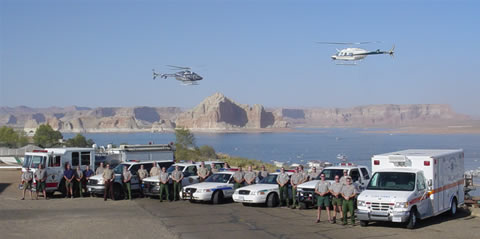|
||
|
|
Playing It Safe At Lake Powell
By Patrick Horning As the 2007 summer boating season approaches we all should start thinking about boating safety. In fact, we should not allow ourselves to stop thinking about safety around the water even in the winter and spring months. Already this year Lake Powell has seen its share of fatalities. We are all crossing our fingers and hoping that it will be a safe year and that our early fatal accidents are not a sign of things to come this summer. So, what can we do to help your trip to Lake Powell be accident free? It’s a tough question because just as we manage to get the information out about carbon-monoxide poisoning, cliff jumping re-emerges as a big problem. Will it be personal watercraft, fires, or alcohol that becomes the big problem here this year? The truth is that a trip to Lake Powell can combine so many activities that can cause injury that we have to be mindful of all we do. You may get your whole party out to the camp spot in one piece only to have an accident from a simple slip and fall aboard your vessel to a broken leg while playing volleyball on the beach. Yes, even though your activity is boating, you have brought along many of the everyday risks you experience at home. Let’s call it Flawless Execution — a simple, yet amazingly wonderful way to manage your trip or everyday life. If it works for our nation’s jet fighter pilots and our rescue teams, why not apply the simple techniques to your vacation? It’s very simple: PLAN, BRIEF, EXECUTE, DEBRIEF, WIN This process will allow everyone to work together with the ability to make informed decisions within their range of the trip. The planning portion should include an itinerary for the parties’ travel on the lake, who is to bring what supplies and equipment, and should give everyone a chance to pursue their interests whether it’s fishing, wakeboarding, sightseeing, or just finding a time to read a good book in a beautiful place. We brief everyone on the plan and use their ideas to modify it. Here at Glen Canyon the first thing that rescuers do is have this conversation. This is what we face; And the most important part — Now you talk to me. This conversation passes on loads of information, allows for input and a different perspective on the leader’s perception and improves the mission overall. At night, debrief the day and before dinner, ask for ideas about tomorrow’s operational goals and objectives. This gives you a chance to modify the itinerary if needed. This five-minute discussion will also serve as tomorrow’s debrief. More Preparations For Safety With all that said, there are some other things I think you should know. You need to have a reliable form of communications. Cell phones don’t always have service, and you should know where on the lake you do get service. Obviously the backs of steep canyons are not conducive to cell phone use. Marine Radio is monitored 24 hours a day by the National Park Service on Channel 16, but even with the powerful radios, the National Park Service advises that sometimes you will have to move to get your message through. Lots of accident victims get evacuated by the fantastic services of Classic Lifeguard Helicopters; they can reach almost anywhere on the lake in under 45 minutes of flight time. But, if they are on their way to Flagstaff with the last victim when you have your accident, the wait can be long. Learn first aid, have a well-stocked kit and be prepared to render aid for long periods of time. Accident victims’ chances of survival soar with the administration of proper first aid if given quickly; recovery times decrease if good care is rendered immediately. Have a plan, brief it, and execute it if an injury should happen. Some Final Points To Remember Hopefully I have put some new ideas in your head. I only need to remind you of a few things.
Have a great trip to Lake Powell and remember to wave at the Buoy Boys! |
|
 March
2007
March
2007